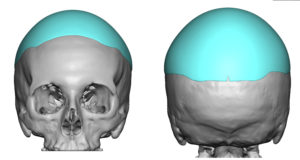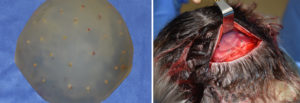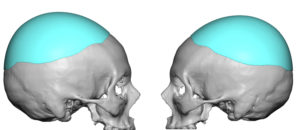Background: While skull surgery has been around for more than a century, such surgeries have been done for reconstructive reasons to replace missing portions or correct significant congenital skull shape deformities. Aesthetic skull surgery, however, is much more recent and consists of reducing prominent bony areas or improving its shape through augmentation materials. The use of custom implants made from the patient’s 3D CT scan is the most effective skull augmentation material today.
One of the more common aesthetic skull deformities that is treated by a custom implant is that of the crown. The crown refers to the area at the upper back of the skull. It begins at the point where the top of the head begins to curve downward to the back of the head and ends at a point just above the nuchal line of the occipital bone. It is semi-circular in shape.
A crown skull deficiency is a common female concern and is often manifest by hairstyle manipulations to camouflage a deficiency or in an effort to make a normal crown look even higher. The commonality of this head shape concern is evident in the commercial product known as a ‘Bumpit’ which serves as an external prosthetic means to make the hair on the crown area look higher or fuller.


While a custom made approach to implant fabrication for augmenting aesthetic flat skull contours is always ideal, certain types of skull augmentations may be able to be done with preformed skull implants. The crown of the head is one of the most amenable to this approach even that its surface area of coverage needed is fairly standard. The amount of implant thickness that the typical female scalp can stretch is also well known by experience and that is usually up to 15mms of central projection.
For those females that have a crown skull deficiency, this type of ‘bumpit’ implant that is performed may work well for their aesthetic needs. Not having to get a 3D CT scan and have a custom implant designed does lower the overall cost of the surgery.
Highlights:
- 1) One of the most common skull augmentations is in females who have a crown deficiency.
- 2) A custom skull implant is traditionally used in all large surface area skull augmentations.
- 3) Standard shaped and sized skull implants can be effective for crown skull augmentations which avoids the needs for a preoperative 3D CT and time needed for implant planning.
Dr. Barry Eppley
Indianapolis, Indiana





